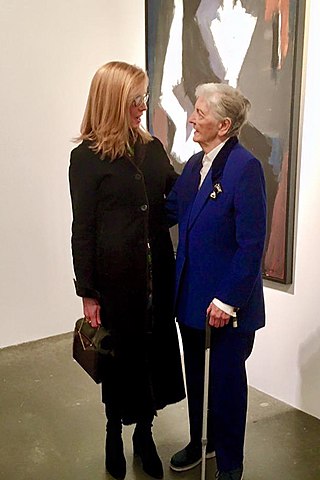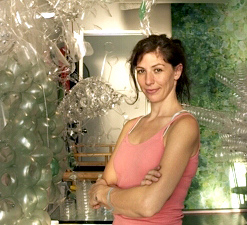Related Research Articles

The Isabella Stewart Gardner Museum is an art museum in Boston, Massachusetts, which houses significant examples of European, Asian, and American art. Its collection includes paintings, sculpture, tapestries, and decorative arts. It was founded by Isabella Stewart Gardner, whose will called for her art collection to be permanently exhibited "for the education and enjoyment of the public forever."

Kelly Richardson is a Canadian artist working with digital technologies to create hyper-real landscapes. She is currently a professor at the Department of Visual Arts of the University of Victoria.
Ambreen Butt is a Boston-based Pakistani American artist best known for her drawings, paintings, prints, and collages, and has been recognized for her labor intensive, painted self-portraits that portray feminist and political ideas through traditional Persian art. She now resides in Dallas, TX.

Artpace is a non-profit contemporary art foundation located in downtown San Antonio, Texas that is free and open to the public. Founded by artist, collector, and philanthropist Linda Pace, Artpace opened its doors in 1995, and focuses on nurturing the creative and artistic processes of both established and emerging artists. Fostering opportunities for dialogue and social interactions between artists and community members of all ages has always been central to the various programs at Artpace.
Salvatore Scarpitta was an American artist best known for his sculptural studies of motion.

Judith Godwin was an American abstract painter, associated with the Abstract Expressionist movement.
Jungil Hong, also known as Jung-li Hong, is a Korean-American artist based in Providence, Rhode Island. She is best known for her psychedelic, cartoon-inspired silkscreen poster art and paintings. More recently she has expanded into textiles.
Valerie Jaudon is an American painter commonly associated with various Postminimal practices – the Pattern and Decoration movement of the 1970s, site-specific public art, and new tendencies in abstraction.
Jiha Moon is a contemporary artist who focuses on painting, printmaking, and sculptural ceramic objects. Born in Daegu, South Korea, Moon is currently based in Tallahassee, Florida, after years of living and working in Atlanta, Georgia. She joined Florida State University's Art department faculty in the fall of 2023.

Joyce J. Scott is an African-American artist, sculptor, quilter, performance artist, installation artist, print-maker, lecturer and educator. Named a MacArthur Fellow in 2016, and a Smithsonian Visionary Artist in 2019, Scott is best known for her figurative sculptures and jewelry using free form, off-loom beadweaving techniques, similar to a peyote stitch. Each piece is often constructed using thousands of glass seed beads or pony beads, and sometimes other found objects or materials such as glass, quilting and leather. In 2018, she was hailed for working in new medium — a mixture of soil, clay, straw, and cement — for a sculpture meant to disintegrate and return to the earth. Scott is influenced by a variety of diverse cultures, including Native American and African traditions, Mexican, Czech, and Russian beadwork, illustration and comic books, and pop culture.
Yoshimi Futamura is a Japanese ceramic artist who has worked and lived in France since 1986. She was born in 1959, in Nagoya, Aichi Prefecture.

Aurora Robson is a Canadian-American artist who works in sculpture, installation, painting and collage, focusing on themes related to the environment.

Larry "Poncho" Brown is an American artist, who began as a sign painter professionally, and has worked in both painting and sculpture. He has also worked as a curator. His work has been shown in exhibitions, television series, and multi-disciplinary art pieces.
Ana Prvacki is a conceptual performance and installation artist who has exhibited internationally. She is known for exploring social interactions in her work and using music to express core ideas such as eroticism.

Cecile Chong is an American artist based in Brooklyn, New York, whose work addresses the process of cultural assimilation and the development of individual identity. For many years she has contributed to New York City public school art programs as a teaching artist.
Devon Dikeou is an American artist, publisher, and art collector. Dikeou’s practice investigates the "in-between" — subtle interactions between artist, art object, viewer, space, and context.
McColl Center is an artist residency and contemporary art space located at 721 North Tryon Street in Charlotte, North Carolina. Residencies last from two months to eleven months and are available to visual artists as well as creative people in other disciplines. The mission of McColl Center is to encourage collaboration and interaction between artists and the community at large in an immersive atmosphere.

Sana Musasama is an African-American ceramic and mixed-media artist based in New York City. Her artistic practice parallels her work as an educator and commitment to human rights causes especially the human trafficking of women. Musasama is an associate adjunct professor at Hunter College.
Adriana Corral is an American artist born in El Paso, Texas, who focuses on installation, performance, and sculpture. Her artwork often emphasizes themes of memory, contemporary human rights violations, and under-examined historical narratives. Corral completed her B.F.A. at the University of Texas at El Paso in 2008 and her M.F.A. at the University of Texas at Austin in 2013. Her work has been exhibited at the Betty Moody Gallery, Houston, Boulder Museum of Contemporary Art, Mexic-Arte Museum in Austin, Texas, Blue Star Contemporary in San Antonio, Texas, the McNay Art Museum, and Massachusetts Museum of Contemporary Art. She has received a series of awards recognizing her work including The Joan Mitchell Foundation Emerging Artist Grant, The MacDowell Colony Grant, and The National Association of Latino Arts and Culture Grant.
Mari Hernandez is a photographer known for her self-portraits that reflect Chicana cultural identity. She is a co-founder of Más Rudas, a Chicana artist collective. She has had works exhibited at the National Portrait Gallery, Crystal Bridges Museum of American Art, Artpace, and the Galveston Art Center.
References
- ↑ "Nature Morte: Contemporary artists reinvigorate the Still-Life tradition". Thames & Hudson USA. Retrieved 2016-06-07.
- ↑ Smith, Roberta (4 August 1995). "ART REVIEW; Anchor and Balm For Restless Souls". New York Times. Retrieved 2 June 2016.
- 1 2 3 4 5 Bankemper, Joan (2016). A Good Run: 1983-1990. New York, NY: Edgewise Press, Inc. pp. 33, 38, 115. ISBN 978-1-893207-35-6.
- ↑ Gualdoni, F (1985). Salvatore Scarpitta 1958-1985. Milan: Padiglione d'arte Contemporanea. p. 46.
- ↑ "Salvatore Scarpitta: Traveler Opening Night". THE HIRSHHORN INSIDER. Retrieved 2016-06-02.
- ↑ Scarpitta, Salvatore (2005-01-01). Salvatore Scarpitta: catalogue raisonné (in Italian). Mazzotta. ISBN 9788820217419.
- ↑ diGenova, G (1990). I Rossori dell'arte. Parma: Galleria Nicoli. p. 68.
- ↑ "Marianne Boesky". www.marianneboeskygallery.com.
- ↑ "Multiples". Richard Milazzo.
- ↑ "Scarpitta / Bankemper: Sal is Racer Preview". Vimeo.
- ↑ "Scarpitta / Bankemper: Racer's Tattoo preview". Vimeo.
- ↑ "Scarpitta / Bankemper: Potato Masher Preview". Vimeo.
- ↑ "Scarpitta / Bankemper: Message to Leo preview". Vimeo.
- ↑ "Scarpitta / Bankemper: Crash preview". Vimeo.
- 1 2 3 www.tendercreative.com, TENDER -. "Isabella Stewart Gardner Museum : Bankemper, Joan". www.gardnermuseum.org. Retrieved 2016-06-02.
- ↑ Temin, Christine (July 14, 2000). "HOW DOES THE GARDNER GROW? JOAN BANKEMPER'S FERTILE VISION GIVES RISE TO SENSUAL PAINTINGS AND FUNKY SCULPTURE". Boston Globe. Archived from the original on September 11, 2016.
- ↑ Hixson, Kathryn (1998). Joan Bankemper 98.2. San Antonio, TX: Art Pace.
- 1 2 "Artist Joan Bankemper Receives McColl Center Gabi Award". Wray Ward. Retrieved 2016-06-02.
- ↑ Gallery, Matt Moores, Nancy Hoffman. "Joan Bankemper | Nancy Hoffman Gallery". www.nancyhoffmangallery.com. Retrieved 2016-06-02.
{{cite web}}: CS1 maint: multiple names: authors list (link) - ↑ "Crockery Heaven - The New York Sun". www.nysun.com. Retrieved 2016-06-02.
- ↑ "SmackMellon.org :: Foodshed". smackmellon.org. Retrieved 2016-06-02.
- ↑ "Black Meadow Barn". JOAN BANKEMPER. Retrieved 2016-06-07.
- ↑ "Joan Bankemper". liptonarts.com. Retrieved 2016-06-02.
- ↑ "Art in the Anchorage 12: Affirmative Actions: Artists at Work - Creative Time". Creative Time. Retrieved 2016-06-02.
- ↑ "Archived copy" (PDF). Archived from the original (PDF) on 2016-01-03. Retrieved 2016-06-02.
{{cite web}}: CS1 maint: archived copy as title (link) - ↑ "New Museum - Digital Archive". archive.newmuseum.org. Retrieved 2016-06-02.
- ↑ "LiptonArts -". www.liptonarts.com.
- ↑ "Joan Bankemper » Artpace". www.artpace.org. Retrieved 2016-06-02.
- ↑ "Joan Bankemper | Artists In Residence | McColl Center for Art + Innovation". mccollcenter.org. Retrieved 2016-06-02.
- ↑ "George Sugarman Foundation". www.georgesugarman.com. Retrieved 2016-06-02.